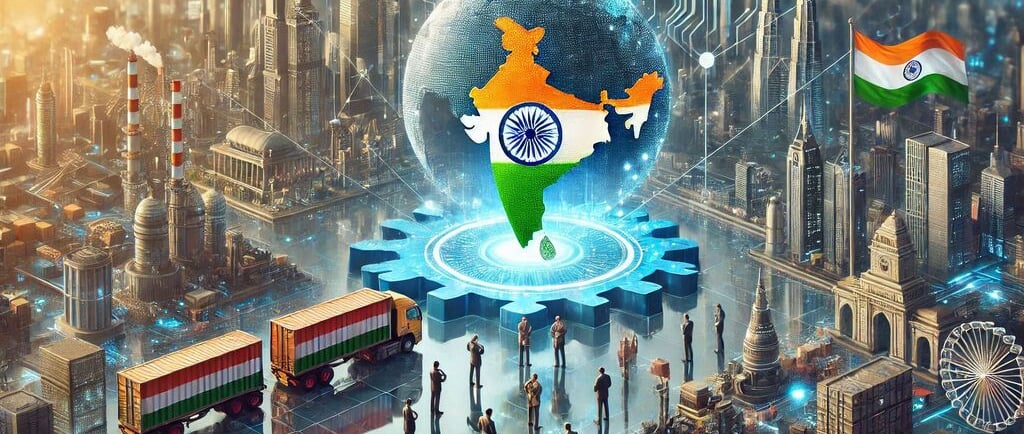Let us collaborate to foster global growth and development together.
The Role of India in the Global Supply Chain: A Comprehensive Analysis
Explore India's growing role in the global supply chain and how its strategic advantages impact international trade and logistics.
INDIA
10/31/20243 min read


The Role of India in the Global Supply Chain: A Comprehensive Analysis
Meta Description: Explore India's growing role in the global supply chain and how its strategic advantages impact international trade and logistics.
Over the last decade, India has emerged as a critical player in the global supply chain. As economies worldwide seek diversification and resilience, India’s unique geographic, economic, and human capital advantages are positioning it as a major manufacturing and logistics hub. Whether you’re a business leader, a trade enthusiast, or simply curious about global economics, understanding India’s growing role in the global supply chain is essential.
Why India Holds the Spotlight in the Global Supply Chain
A Strategic Location with Global Connectivity
India's geographical location offers businesses a strategic gateway between East and West. With major ports such as Mumbai, Chennai, and Kolkata, India connects seamlessly to Europe, the Middle East, and Asia-Pacific markets.
Proximity to Emerging Markets: India’s location makes it a cost-effective hub for reaching countries in South Asia, Southeast Asia, and beyond.
Maritime and Air Infrastructure: Ports like Jawaharlal Nehru Port Trust (JNPT) and state-of-the-art airports strengthen India's logistics capabilities.
Abundant Workforce and Competitive Labor Costs
India is home to a young and skilled workforce, with millions entering the job market annually. The availability of talent at competitive labor costs has attracted multinational corporations to set up manufacturing units.
India’s Key Sectors Driving Global Supply Chains
1. Information Technology (IT) and Software Services
India dominates the global IT services sector, contributing over 55% of the world’s outsourced IT work. Giants like Infosys and TCS play a crucial role in maintaining operational continuity for businesses worldwide.
High-quality Workforce: Strong engineering and tech talent pool ensures India remains a preferred outsourcing destination.
Remote Work Compatibility: A robust digital infrastructure supports remote services, ensuring supply chain stability.
2. Pharmaceuticals and Healthcare
Known as the "pharmacy of the world," India produces over 20% of the world’s generic drugs. This sector gained prominence during the COVID-19 pandemic as India supplied vaccines and essential medications globally.
Regulatory Expertise: Indian manufacturers comply with global standards, including FDA and EMA requirements.
Cost Advantage: Affordable production significantly reduces costs in healthcare supply chains.
3. Automobile and Electronics Manufacturing
Programs like Make in India are bolstering manufacturing in automotive and electronics. Major brands such as Tesla, Apple, and Hyundai increasingly rely on India for components or assembly lines.
Growing Exports: India is emerging as a key player in exporting cars and electronic goods, rivaling other Asian markets.
Investment-Friendly Policies: Tax breaks and subsidies are attracting foreign investors to build factories in India.
Challenges India Faces in Strengthening Supply Chains
Infrastructural Gaps
While major cities boast strong infrastructure, rural areas often face challenges, such as poor road conditions and limited connectivity.
To counter this, the Indian government has launched initiatives like the National Infrastructure Pipeline (NIP) and Bharatmala Project, aiming to build world-class highways and transportation networks.
Regulatory Complexities
Navigating India’s regulatory landscape can be daunting due to varying regional policies. Companies looking to invest must plan thoroughly to address these challenges.
India’s Steps to Strengthen Global Integration
Adoption of Emerging Technologies
The integration of Industry 4.0 practices, such as AI and IoT, is modernizing Indian industries. Smart factories equipped with predictive analytics tools ensure greater efficiency and quality in production.
Policy Support and Free Trade Agreements (FTAs)
India is actively negotiating trade agreements with countries such as the UK, EU, and Australia to simplify market access and boost exports. Policies like the PLI Scheme (Production-Linked Incentive) are further incentivizing domestic and international manufacturing.
Actionable Tips for Businesses Considering India
Partner with Local Experts: Building relationships with Indian trade associations or consultants ensures smoother entry and compliance with local regulations.
Leverage Special Economic Zones (SEZs): Take advantage of India’s SEZs, which offer tax breaks, fast-track approvals, and high-quality infrastructure for exporters.
Focus on Sustainability: Incorporate green manufacturing practices, as India prioritizes sustainability to attract international collaborations.
India’s Role in a Resilient Global Supply Chain
Amid disruptions caused by the pandemic and geopolitical tensions, businesses worldwide are shifting to multi-country sourcing. India has become a prime choice, offering both scalability and stability.
Diversification Beyond China: As companies seek alternatives to China, India’s potential to become the “second factory of the world” gains traction.
Regional Stability: India’s participation in initiatives like the Quad and its emphasis on international partnerships boost its credibility as a reliable trade partner.
Conclusion: India as a Global Supply Chain Pillar
India’s influence on the global supply chain is undeniable, driven by its young workforce, strategic location, and expanding industries. While challenges remain, ongoing reforms and innovation make it an increasingly attractive option for international businesses.
What’s next for your supply chain strategy? If you’re exploring new markets, India might hold the key to efficiency and growth. Start by learning more about its trade incentives and industrial hubs.
Check out our related articles, such as “Streamlining International Trade Logistics” or “Understanding Emerging Markets in 2024,” and let us know your thoughts in the comments!
Innovation
Cutting-edge solutions for industrial efficiency and productivity.
© 2024. All rights reserved.


